Introduction
Glacier National Park, a gem in the U.S. National Park System, is renowned for its dramatic peaks, pristine forests, and stunning glaciers. In the winter months, this rugged landscape undergoes a magical transformation, blanketed in a thick layer of snow that shimmers under the clear, crisp skies. The park’s vast wilderness becomes a quiet, frozen wonderland, offering a serene escape for those seeking the beauty and solitude of nature in its most peaceful state.
Rivers and lakes freeze over, waterfalls turn into glittering ice sculptures, and the park’s iconic wildlife adapts to the harsh, snowy conditions, creating a dynamic and fascinating ecosystem for visitors to observe. This dramatic seasonal change not only enhances the park’s beauty but also spawns new avenues for winter enthusiasts with cross-country skiing as one of the most immersive ways to explore the park’s wintry splendor.
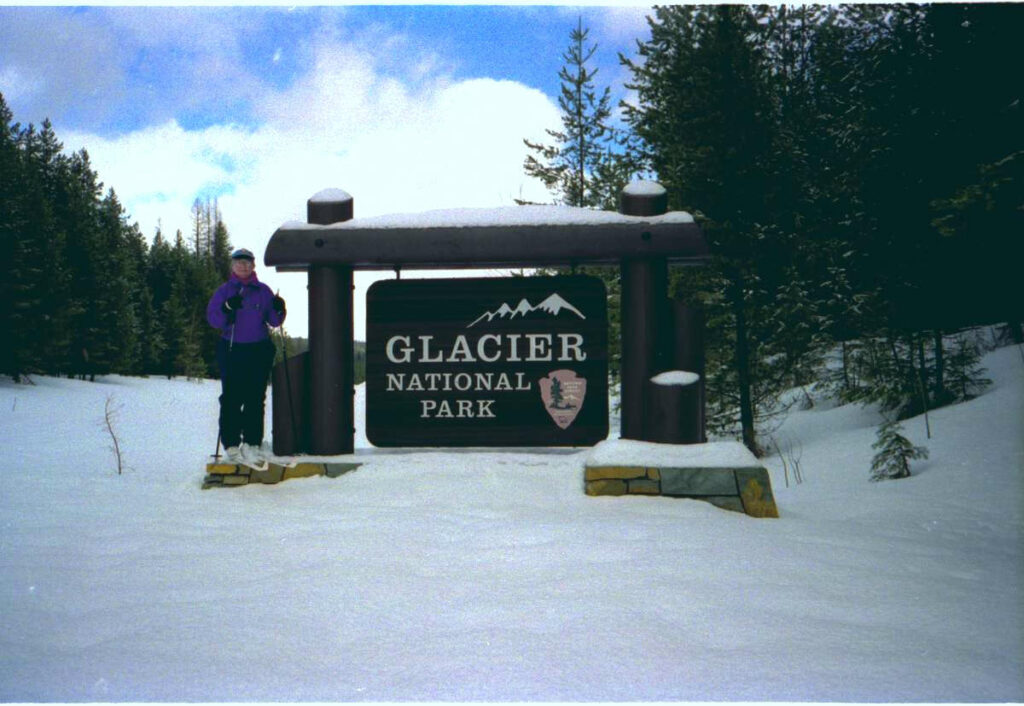
The Appeal of Cross-Country Skiing in Glacier Park
Cross-country skiing in Glacier National Park has grown in popularity for several compelling reasons. Firstly, it offers an unparalleled way to connect with the natural world, providing a quiet, rhythmic experience that differs markedly from more adrenaline-fueled winter sports. Skiers glide through snow-laden forests, across frozen meadows, and along rivers veiled in ice, often in solitude and silence aside from the occasional wildlife encounter. This form of skiing is not just about physical exercise; it’s a meditative journey into the heart of winter’s beauty.
The park’s diverse range of trails cater to all skill levels, from flat and forgiving routes for beginners to challenging distances for the more experienced. This inclusivity makes the sport accessible to a wide audience, from families looking for a unique winter outing to seasoned adventurers looking to test their endurance against the elements.
Cross-country skiing is relatively cost effective, offering a low barrier to entry compared to alpine skiing, and although the health benefits of both are abundant, expect a full-body workout from cross-country skiing.
The sport offers a sustainable, low-impact way to enjoy the park, aligning with the values of conservation and respect for the natural world. Skiers often report feeling a profound sense of connection and responsibility towards the landscape, fostering a deeper appreciation for the park’s beauty and the need to protect it for future generations.
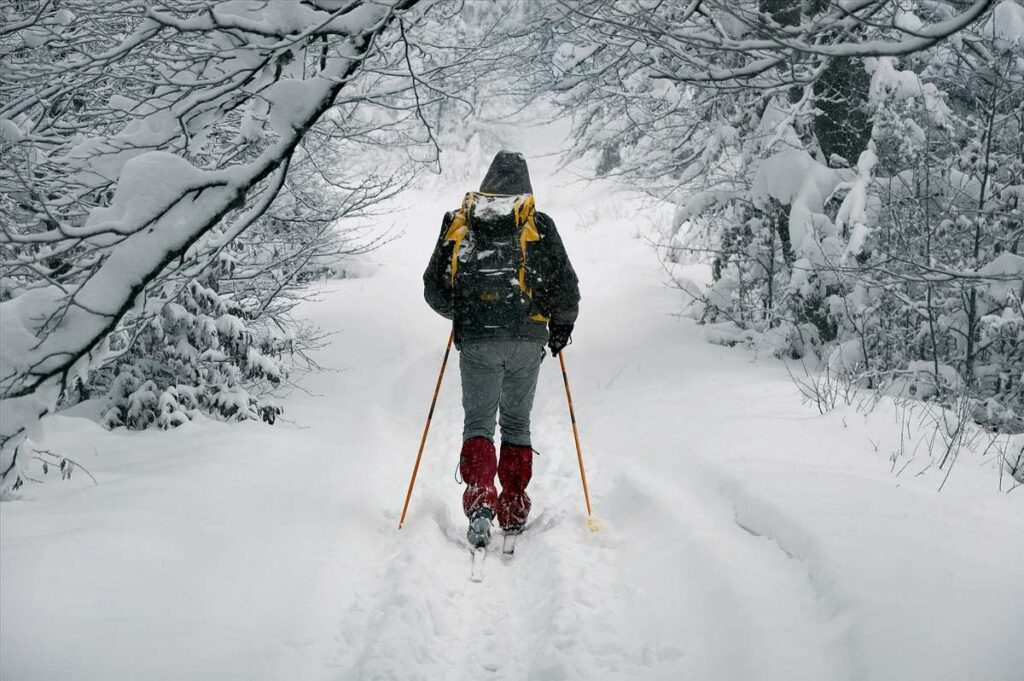
Preparing for Your Adventure
Necessary Equipment and Clothing for Cross Country Skiing
1. Skis, Poles, Boots
The foundation of a successful cross country skiing trip lies in selecting the right gear. For skis, there are two main considerations: classic and skate. Classic skis are best for beginners and those planning to ski on groomed trails, while skate skis are suited for more experienced skiers looking for speed and maneuverability on packed snow. The length and width of the skis will depend on your weight and the style of skiing you prefer. Poles should reach your armpits (for classic skiing) or the top of your shoulders (for skate skiing), ensuring efficient propulsion. Boots must be compatible with your bindings and should offer a snug, comfortable fit to keep your feet warm and to prevent blisters during long treks.
2. Layers, Thermal Wear, and Protective Gear
Dressing in layers is crucial for maintaining body temperature and comfort during cross country skiing. Start with a moisture-wicking base layer to keep sweat away from your skin, add an insulating layer such as fleece or wool for warmth, and finish off with a waterproof, breathable outer layer to protect against wind and snow. Don’t forget thermal socks, gloves or mittens, a warm hat, and a neck gaiter or face mask. Sunglasses or goggles are essential for protecting your eyes from the glare of the snow and UV exposure, while sunscreen should be applied to exposed skin to prevent sunburn, even on cloudy days.
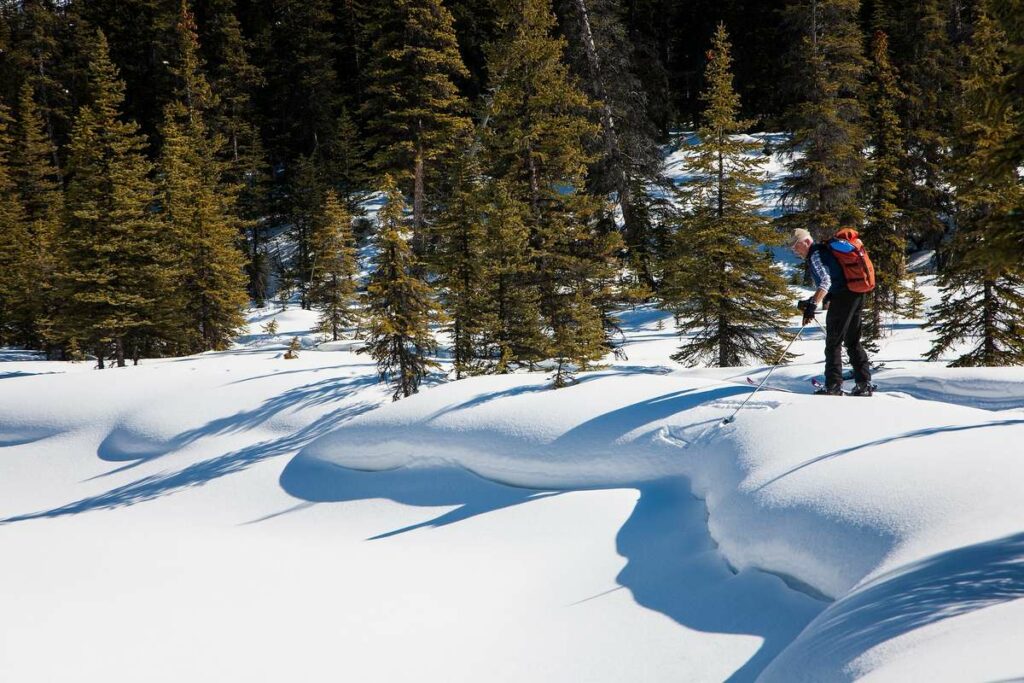
Safety Considerations and Navigation
1. Weather Conditions and Avalanche Risk
Before heading out, it’s vital to check the weather forecast and avalanche risk for the area you plan to ski in. Weather in Glacier National Park can change rapidly so be prepared for varying conditions, including sudden drops in temperature and snowstorms. If your route takes you into areas prone to avalanches, consider carrying avalanche safety equipment, such as a beacon, probe, and lightweight shovel, and make sure you know how to use all of them. Of course, many cross-country skiing trails in the park are situated in safer, less avalanche-prone areas.
2. GPS, Maps, and Compass Usage
Even on marked trails, it’s easy to become disoriented in a winter landscape. Carry a GPS device, a detailed map of the area, and a compass, and know how to use them. Familiarize yourself with your route in advance and always let someone know your planned itinerary and expected return time. A smartphone with a GPS app can be a useful backup but should not be relied upon as your primary navigation tool due to batter-life limitations in cold weather.
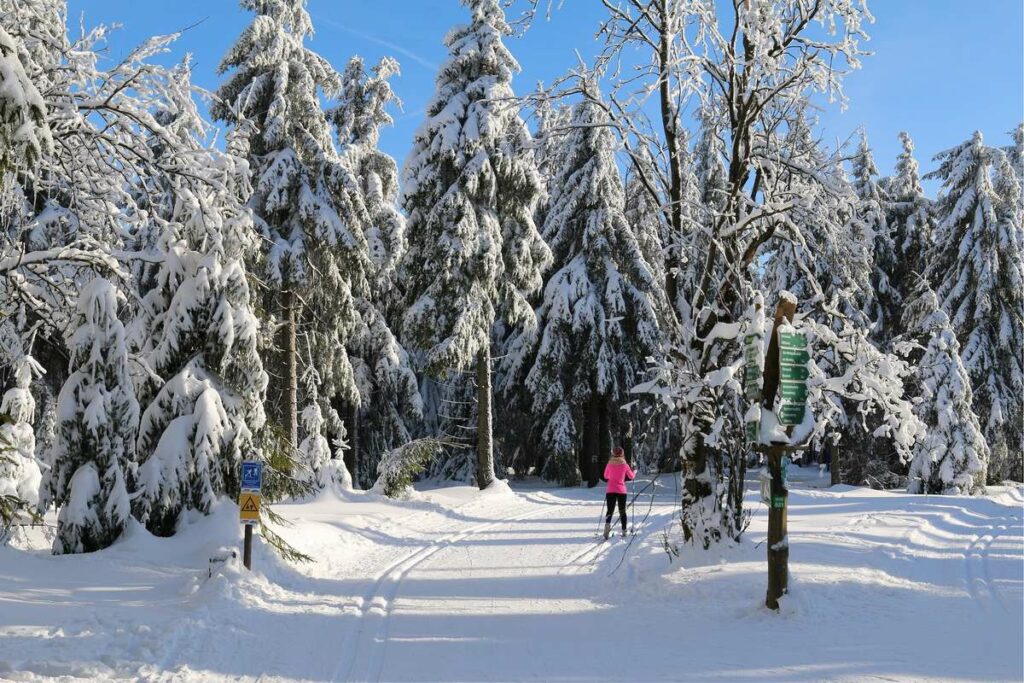
Permits and Regulations for Skiing in the Park
Before you set out on your cross-country skiing adventure in Glacier National Park, it’s important to be aware of required permits or regulations that might be in place. While winter access to the park is generally open, specific areas may require permits, especially for overnight trips. Check the park’s official website or contact the visitor center for the most current information on trail conditions, closures, and permit requirements.
Some areas of the park may also have specific regulations to protect wildlife or sensitive environments and it’s essential to adhere to these rules to ensure the park remains pristine for future visitors. Being well-prepared with the right knowledge and respect for the environment will make your cross-country skiing experience more enjoyable and safe, allowing you to fully immerse yourself in the stunning winter beauty of Glacier National Park.
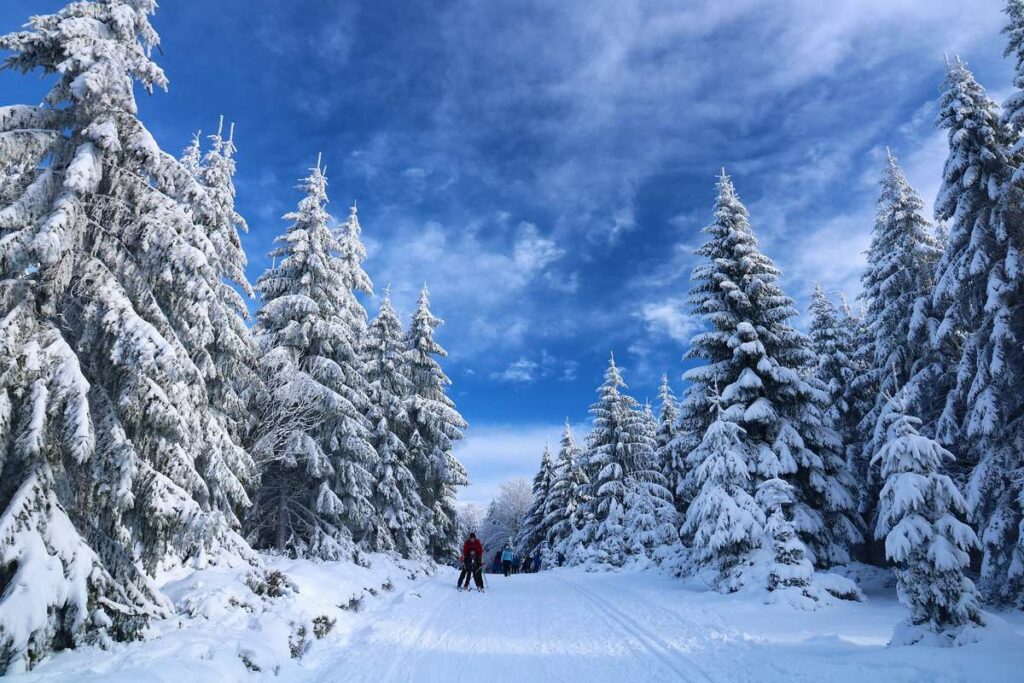
Best Trails for Cross Country Skiing in Glacier National Park
Glacier National Park offers a diverse collection of cross-country skiing trails that cater to all levels of experience, from the novice to the seasoned skier. These trails vary widely in terms of difficulty, length, and the type of terrain they encompass, providing something for everyone. Beginners can enjoy flat and scenic routes, while more experienced skiers may seek out trails with challenging climbs and thrilling descents. The park’s vast landscape offers a truly unique skiing experience, surrounded by the breathtaking beauty of Glacier’s winter wilderness.
Highlighted Trails
1. Going-to-the-Sun Road
The iconic Going-to-the-Sun Road that winds through the heart of the park offers a unique cross country skiing experience while closed to vehicular traffic in the winter. This trail provides relatively easy skiing along a gently graded road with spectacular views of the surrounding peaks and valleys. It’s an excellent choice for skiers of all skill levels, offering the chance to glide past frozen waterfalls, snow-covered forests, and the possibility of spotting wildlife along the way.
2. Apgar and West Glacier Areas
The Apgar and West Glacier areas serve as fantastic starting points for cross country skiers, offering a variety of trails ranging from easy to moderate in difficulty. These areas are known for their flat terrain and breathtaking scenery, including views of Lake McDonald and the Apgar Mountains. The accessibility and scenic beauty of these trails make them perfect for families and beginners.
3. Bowman and Kintla Lakes
For those seeking solitude and a more challenging skiing experience, the trails around Bowman and Kintla Lakes in the park’s North Fork area are ideal. These remote trails offer longer distances and require skiers to be self-sufficient and well-prepared for backcountry conditions. The reward is unparalleled peace and the chance to ski through some of the park’s most pristine and untouched landscapes.
4. Marias Pass
Marias Pass, located along the southern boundary of the park, offers a unique cross country skiing experience with its varied terrain and historical significance. The trails range from easy to difficult, offering something for every level of skier. The area is known for its deep snowpack and offers stunning views of Glacier’s peaks, as well as the opportunity to explore old growth forests and open meadows.
Each trail in Glacier National Park offers a unique window into the park’s winter wonders, from serene lakeside paths to challenging backcountry adventures. Skiers are treated to an array of experiences, from breathtaking vistas and peaceful forest glides to exciting wildlife encounters, making each trail a distinct and memorable journey into the heart of Montana’s wilderness.
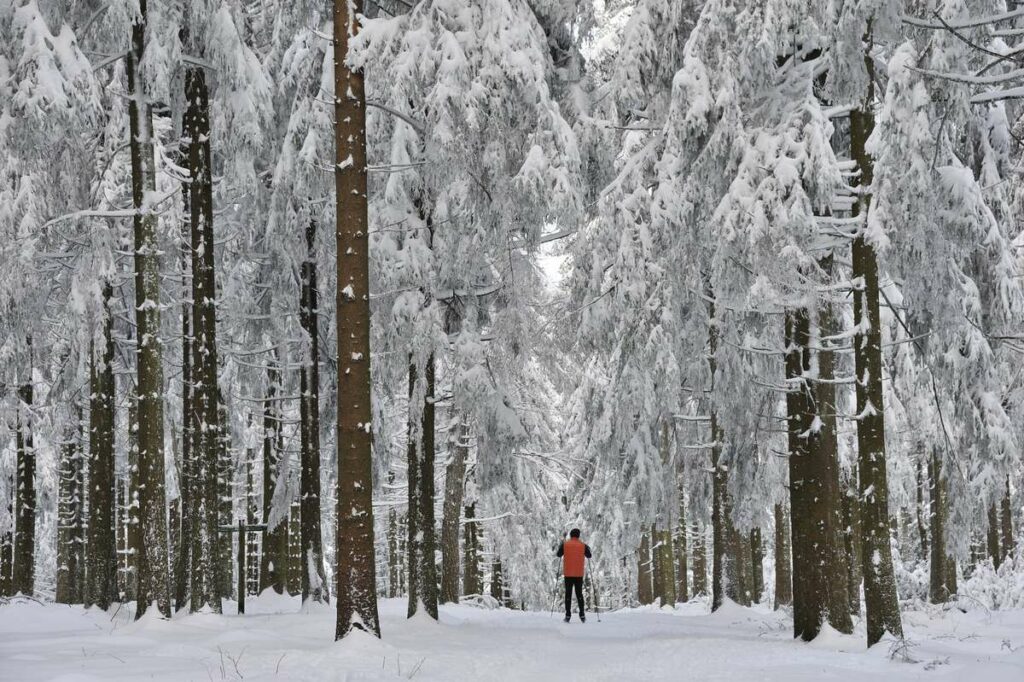
Wildlife and Scenery
Winter in Glacier National Park transforms the landscape into a quiet, snowy wonderland, offering unique opportunities to observe wildlife in their natural habitat. The stark contrast of the white snow against the dark silhouettes of trees and mountains creates an enchanting setting for wildlife viewing. Common winter residents include:
- Elk and Deer: These majestic creatures are often seen foraging in the lower valleys where snow is less deep, providing excellent viewing opportunities
- Mountain Goats and Bighorn Sheep: Adapted to the rugged terrain and harsh winter conditions, these animals are frequently spotted on rocky outcrops, utilizing the steep cliffs to evade predators
- Wolves and Coyotes: With the snow making it easier to track their movements, these elusive predators can sometimes be seen in the early morning or late afternoon, hunting or traversing the frozen landscape
- Birds of Prey: Winter is an excellent time for bird watching, as bald eagles, owls, and other raptors can be seen perched in trees or soaring above open areas, searching for food
Photographic Opportunities and Scenic Points
Glacier National Park’s winter landscape offers unparalleled photographic opportunities, from vast snowy vistas to intimate portraits of wildlife. Key scenic points and opportunities include:
- Lake McDonald: The largest lake in the park, known for its clear, reflective waters and stunning backdrop of mountains offers dramatic sunrise and sunset photographic opportunities
- Going-to-the-Sun Road: Provides access to high elevation viewpoints where photographers can capture the grandeur of the park’s mountainous terrain draped in snow
- Many Glacier: Renowned for its scenic beauty with frozen lakes, towering peaks, and the chance to photograph ice formations and wildlife
- Frozen Waterfalls: Locations like Avalanche Creek and the Trail of the Cedars offer the chance to capture the mesmerizing beauty of frozen waterfalls and ice-covered streams
Environmental Preservation and Respecting Wildlife
While enjoying the park’s natural beauty and wildlife, it is crucial to practice environmental preservation and respect for wildlife. Visitors should adhere to the following guidelines:
- Keep a Safe Distance: Always observe wildlife from a safe distance to avoid disturbing them, particularly during the winter when animals are conserving energy to stay warm
- Stay on Designated Trails: To protect the fragile winter ecosystem, visitors should ski on designated trails and avoid areas that are closed for wildlife protection or recovery
- Leave No Trace: Carry out all trash and minimize your impact on the natural environment to help preserve the park’s pristine condition
- Respect Park Regulations: Follow all park rules and regulations, including those related to wildlife interaction, camping and fires, to ensure the safety of both visitors and wildlife
By observing these guidelines, visitors can enjoy the breathtaking scenery and wildlife of Glacier National Park in winter while ensuring that its natural beauty and ecological integrity are preserved for future generations.
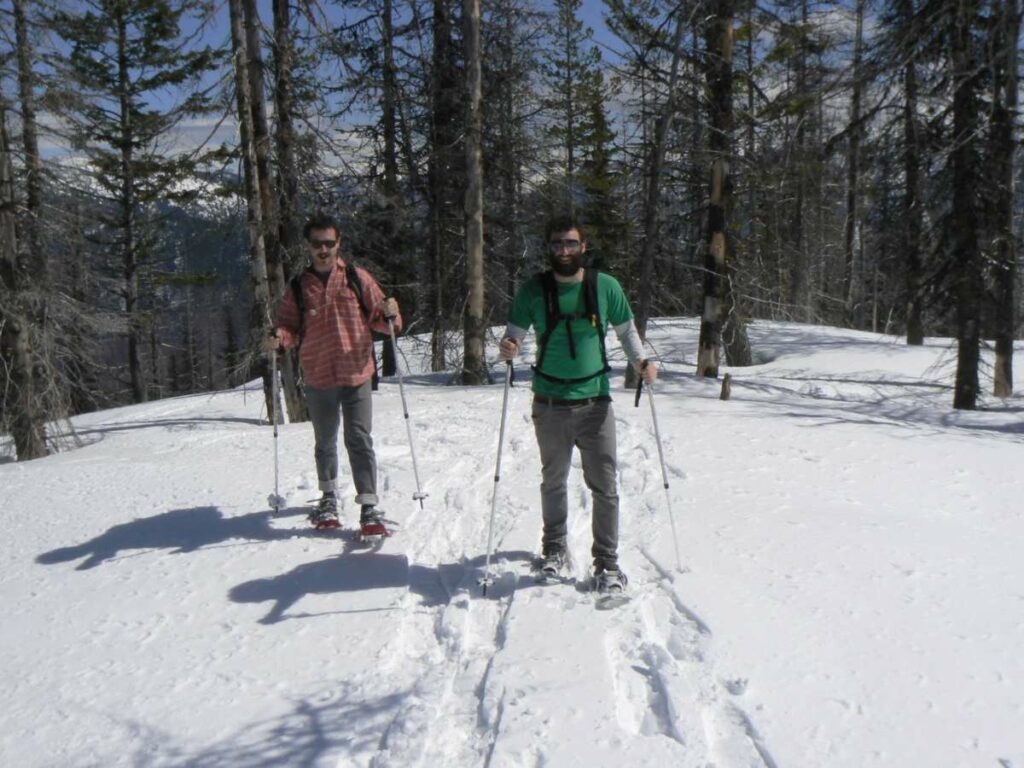
Guided Tours and Skiing Programs
Guided tours in Glacier National Park offer numerous advantages for both novice and seasoned skiers. For beginners, these tours provide a safe and informative introduction to cross-country skiing, covering basics such as technique, equipment use, and navigation. Guides can tailor instruction to individual skill levels, ensuring a rewarding and confidence-building experience. Experienced skiers also benefit from guided tours, as they gain access to expert knowledge of the park’s geography, hidden trails, and the best spots for wildlife viewing that they might not discover on their own.
Furthermore, guided tours emphasize safety, particularly important in winter conditions, offering insights into weather patterns, avalanche risk, and emergency procedures. For all participants, guided tours enrich the skiing experience by incorporating educational content about the park’s natural history, conservation efforts, and cultural heritage, making for a more meaningful visit.
Finding and Booking Tours
To find and book cross country skiing tours in Glacier National Park, visitors should start by checking the official National Park Service website for a list of authorized tour operators. These operators are vetted for safety and quality, ensuring a reliable and enriching experience. Additionally, local visitor centers, outdoor gear shops, and tourism websites for the surrounding communities often provide recommendations and booking services for ski tours.
When selecting a tour, consider the length, difficulty, and thematic focus of the outing to match your interests and skiing ability. Some tour operators also offer customizable private tours for a more personalized experience.
Educational Programs and Workshops
In addition to guided tours, Glacier National Park and local organizations frequently host educational programs and workshops designed to enhance visitors’ winter wilderness skills and knowledge of wilderness adventures. These programs may include workshops on winter survival skills, avalanche safety training, wildlife tracking, and nature photography, among other things.
Educational programs are often led by experts in the field, including park rangers, wildlife biologists, and seasoned wilderness guides, providing participants with high-quality, informative content.
For those interested in deepening their understanding of the park’s ecosystem or improving their outdoor skills, these workshops offer invaluable learning opportunities. Information on upcoming programs can typically be found on the National Park Service website, at visitor centers, or through local outdoor education centers.
Participating in these programs not only enhances the cross country skiing experience but also fosters a deeper connection with the natural environment and promotes responsible outdoor recreation practices.
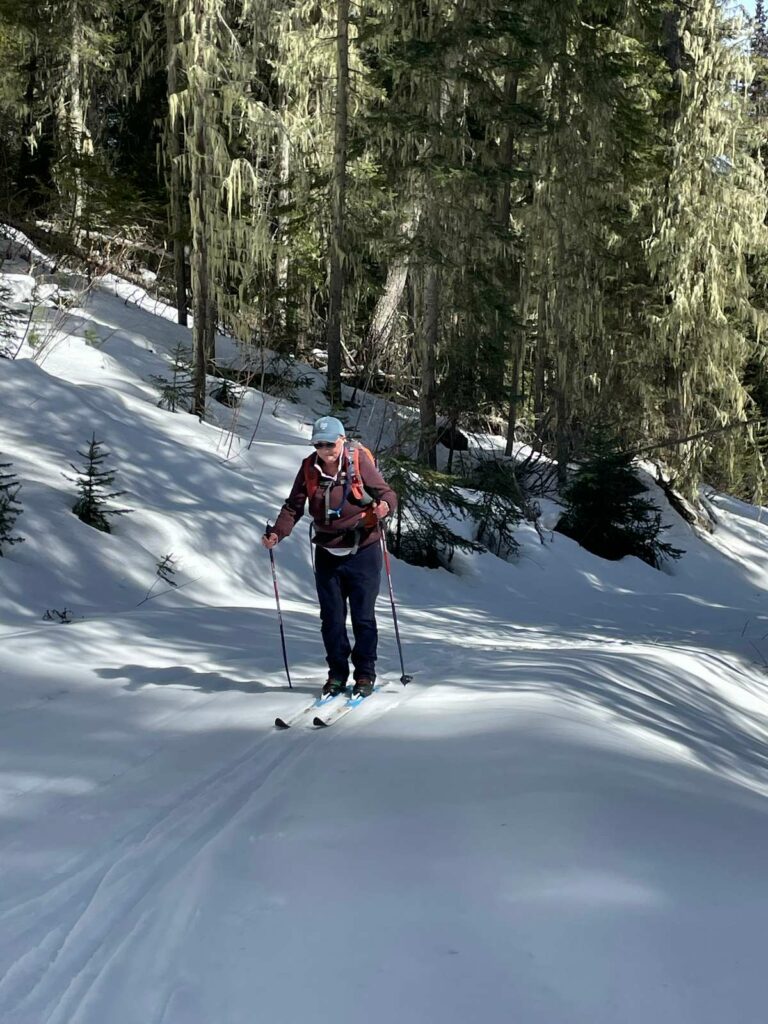
Glacier National Park Lodging Options
Visitors to Glacier National Park in the winter will find a variety of lodging options to suit different preferences and budgets, ranging from cozy cabins and lodges to comfortable hotels and bed & breakfast inns. Many accommodations are strategically located near the park’s entrances, offering easy access to cross country skiing trails and stunning winter landscapes. Some popular options include:
- Historic Lodges: The park and its surrounding areas boast several historic lodges that offer a rustic yet comfortable stay, complete with fireplaces and stunning views of the snow-covered surroundings
- Cabins and Chalets: For those seeking a more secluded experience, renting a cabin or chalet can provide a private retreat after a day of skiing, often equipped with kitchen facilities and more
- Hotels and Motels: Various hotels and motels located in nearby towns like Whitefish, Columbia Falls, and Kalispell offer convenient lodging options with the added benefit of being close to restaurants and other amenities
Relaxing After a Day of Skiing (Local Hot Springs, Dining, etc.)
After a day of skiing, there are plenty of ways to unwind and warm up in the Glacier National Park region. Some notable options include:
- Local Hot Springs: A visit to a nearby hot springs can be the perfect way to relax sore muscles. The region offers several natural hot springs facilities, with both indoor and outdoor pools, where visitors can soak in mineral-rich waters surrounded by snow-covered landscapes
- Dining: The towns surrounding Glacier National Park offer a range of dining options, from cozy cafes serving hearty, locally-sourced meals to fine dining restaurants with menus that showcase the best of Montana’s cuisine. Many establishments feature fireplaces or outdoor fire pits, adding to the ambiance
- Craft Breweries and Distilleries: Montana is known for its craft beer and spirits, and home to several breweries and distilleries where visitors can sample local brews and spirits, often in settings that offer live music or other entertainment
Other Winter Activities in the Area
Beyond cross-country skiing, Glacier National Park and surrounding area offer a plethora of other winter activities to enjoy, such as:
- Snowshoeing: Many of the same trails used for cross country skiing are also excellent for snowshoeing, offering another way to explore the park’s winter beauty
- Ice Fishing: The region’s lakes offer opportunities for ice fishing, a popular winter pastime where anglers can catch trout and other fish
- Winter Wildlife Tours: Guided wildlife tours are available, offering visitors the chance to learn about and observe the park’s winter animal residents, including elk, deer, eagles, and more in their natural habitat
- Photography Workshops: Winter provides unique photographic opportunities, photography workshops cater to those looking to capture the stunning winter landscape and park wildlife
The combination of breathtaking landscapes, a variety of accommodations, relaxing after-ski activities, and other winter recreational opportunities makes Glacier National Park a premier destination for winter sports enthusiasts and nature lovers alike.
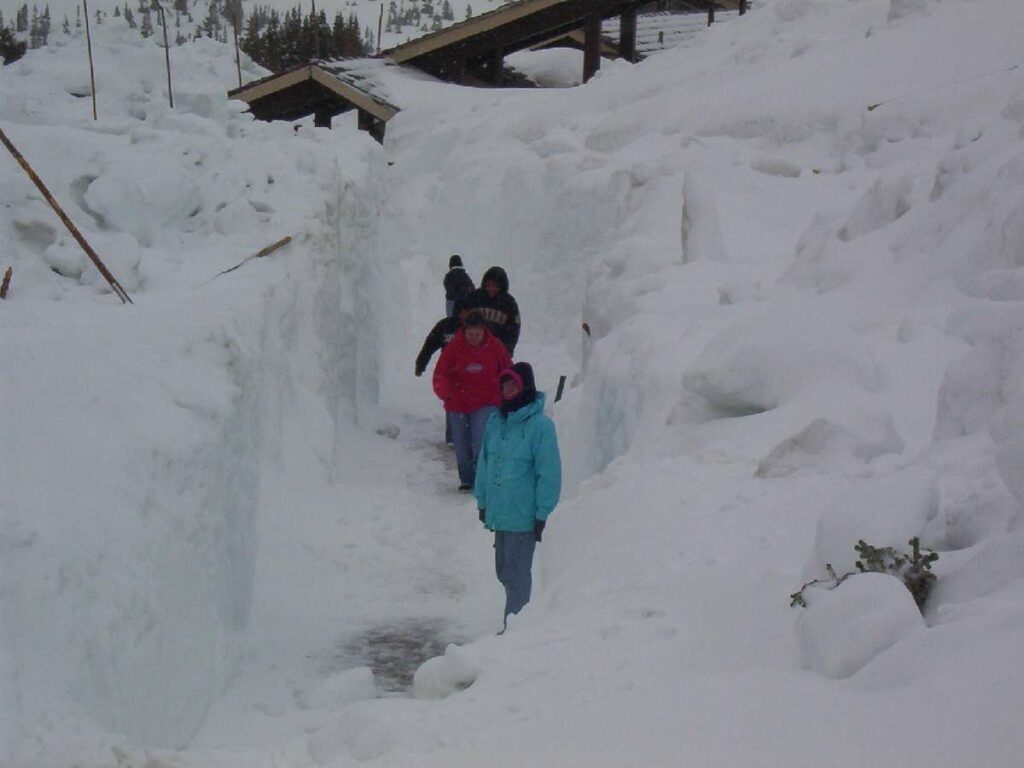
Tips for a Successful Cross Country Skiing Trip
Best Times to Visit for Skiing
The optimal period for cross country skiing in Glacier National Park typically spans from late December through early March. This timeframe usually offers the most stable snow conditions, with January and February being particularly ideal for those seeking the quintessential winter wonderland experience.
However, visitors should be aware that weather conditions can vary greatly, it’s wise to monitor local weather forecasts and park updates closely. Early in the season, snow may be less consistent, while later in the season, warmer temperatures can lead to variable snow conditions. Visiting during weekdays or non-holiday periods can result in a more secluded and intimate experience on the trails.
Local Resources and Emergency Contacts
Before embarking on your trip, compile a list of local resources and emergency contacts. This list should include:
- National Park Service (NPS) Contacts: Have the contact information for the Glacier National Park Visitor Center and any ranger stations. They can provide updates on trail conditions, weather, and safety information
- Local Emergency Services: Keep a list of local emergency numbers, including the nearest hospital, search and rescue services, and park rangers trained in emergency response
- Rental Shops and Guides: Note the contact details of rental shops and guide services you plan to use in the event you need to adjust your equipment or schedule
- Accommodations: Have the contact information for your lodging readily available, along with any after-hours emergency numbers they provide
Lastly, always let someone know your itinerary and expected return time. Check-in with park staff or a local contact before and after your skiing outing. With the right preparation and mindfulness of conditions and safety, your cross-country skiing trip to Glacier National Park can be a memorable and exhilarating experience.
Conclusion
Cross country skiing in Glacier National Park offers an unforgettable adventure that combines physical challenge with the serene beauty of a pristine winter landscape. The park’s varied terrain presents opportunities for skiers of all skill levels, from flat and gentle trails ideal for beginners to more demanding routes that test the endurance and skill of experienced skiers. The joy of gliding through a quiet forest, across frozen lakes, and under towering peaks is unmatched. It’s an immersive experience that connects skiers with the natural world in a profound way.
However, this adventure does not come without its challenges. Winter in Glacier National Park can be harsh and unpredictable, with conditions that change rapidly. Skiers must be prepared for cold temperatures, deep snow, and the potential for avalanches in certain areas. Navigating these challenges requires proper preparation, respect for nature’s elements, and an awareness of personal limits.
Despite these challenges, the rewards of cross-country skiing in Glacier National Park are plentiful and a chance to witness the park’s winter beauty in solitude and silence. The snow-covered landscape, with its ice-sculpted trees and frozen waterfalls offer a perspective of the park that few visitors see. Wildlife sightings, from tracks of solitary animals to the occasional glimpse of deer, elk, or even a lynx, add an extra layer of wonder to the experience.
For those considering this winter journey, you won’t be disappointed. The park’s vastness and beauty in winter can provide profound moments of joy, tranquility, and personal achievement. Whether you’re setting out on a leisurely ski on a groomed trail or embarking on a backcountry adventure, Glacier National Park during winter is a place where memories are made, spirits are lifted, and the heart of the wild is discovered in each snowflake and silent, snowy expanse. Gear up, prepare well, and dive into the experience of cross-country skiing in one of America’s most majestic national parks. The challenges you’ll face are but a small price for the unparalleled beauty and serenity that await in Glacier National Park’s winter wonderland.

